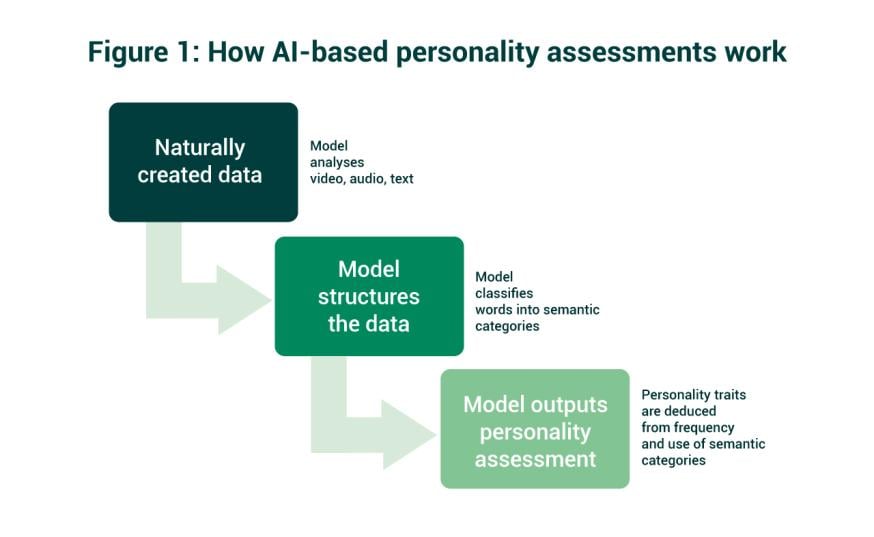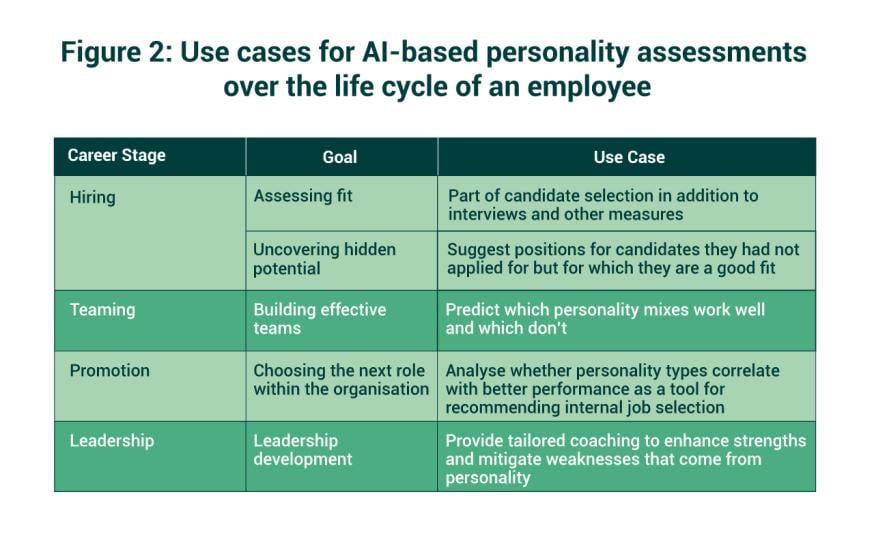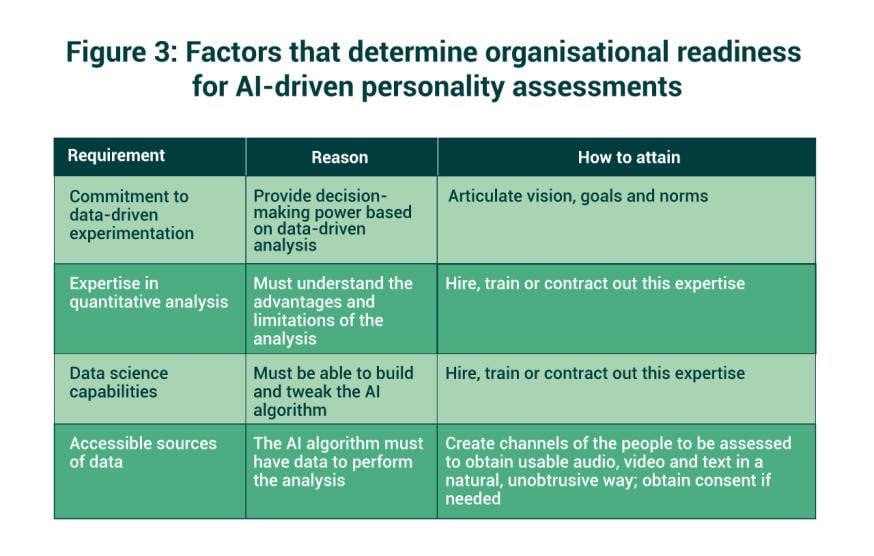
AI’s immense potential is not difficult to see. The current consensus is that every organisation needs AI – although what exactly for is not always clear. The race for finding effective use cases and applications is on.
One opportunity for deploying the technology is to assess personality: an individual’s characteristics that remain consistent across different social situations. People with similar personalities will act similarly in important ways. This means that personality information can be used to predict likely matches and mismatches between colleagues who work together in teams, or between a client and a salesperson or service provider.
Self-reported surveys vs. AI-based assessments
Many organisations put employees through personality assessments to determine everything from hiring to promotion to on-the-job training. These typically involve computerised surveys based on the Big Five or “OCEAN” (openness, conscientiousness, extroversion, agreeableness and neuroticism) personality traits, in which people self-report their preferences and behaviours. However, personality assessments have distinct disadvantages: They rely on self-reporting; feature closed-ended questions; and take a long time to complete, limiting their scalability.
The increasing functionality of AI can lead to a major disruption in how companies evaluate personality. AI-based personality assessments remove the need for self-reporting and close-ended questionnaires, as algorithms can analyse video, audio, speech transcripts of free-flowing interactions and social media information to provide a personality assessment of an individual. This approach is not only faster than making someone fill out a questionnaire but can potentially be more accurate because it captures natural behaviour.
How it works

First, a large-language model (LLM) analyses whatever data there is available for a person, such as video, audio or text. This can be a recording of an interview, a meeting, a presentation or a piece of writing. In the case of video or audio, the algorithm can accurately separate the target person’s speech from that of others.
The algorithm classifies the words using the “Linguistic Inquiry and Word Count” (LIWC) categories – a dictionary that groups English words into linguistic buckets and has been used by academic psychologists since the late 1990s. Research has found correlations between LIWC categories and self-reported personality traits, enabling the algorithm to translate recorded words and phrases into possible indicators of personality attributes.
For example, it can discern whether the recordings are composed of first-person words, positive or negative emotions, optimistic or pessimistic sentiments, and so on. Expressions of negative emotions correlate positively with neuroticism, while references to other people correlate positively with extroversion. Swear words correlate negatively with agreeableness.
Of course, personality traits cannot be deduced based on a few words alone. Sufficient data (typically a few thousand words) is necessary to create composite measures for each person whose personality is being assessed. As more data about an individual comes in, the algorithm can assess personality traits with greater statistical confidence.

Besides its use in hiring, teaming, determining promotions and providing leadership development, AI-based personality assessments can help companies in more tactical ways. For instance, a service-based organisation could evaluate whether personality matches between clients and service providers predict churn, both in the near and long term. Certain personality matches might lead to surprisingly strong client relationships, while other pairings could be especially volatile.
Another possibility is to compute a team-based personality match score to evaluate whether teams with more similar or dissimilar personalities perform better. Still another option is tailoring sales pitches to different clients based on personality assessments.
Implementing this in your organisation
One firm that’s already doing this is Athena, a 2,500-employee company specialising in training and matching executive assistants with entrepreneurs and executives. It uses AI-based personality assessments to rapidly deduce Big Five personality profiles based on recordings of meetings between clients and their executive assistants, which it then uses to help predict churn and inform matching. The company’s findings were at times predictable (highly conscientious clients do well with highly conscientious executive assistants) and at times surprising (clients who are open to novel experiences do well with executive assistants high in neuroticism).
However, AI-based personality assessments aren’t currently widely implemented, and it’s important to understand the caveats and organisational requirements before deploying the technology for yourself.

First, your organisation must have several elements in place to properly implement this approach. This includes a commitment to data-driven experimentation; expertise in quantitative analysis; data science capabilities to build, maintain and tweak the algorithm; and accessible data sources that the algorithm can use to perform its analysis.
Second, it is key to standardise the data produced by the AI to the company’s specific target segment, as this can affect the quality of personality matches the model comes up with. For example, compare a firm that caters to entrepreneurs to one that caters to accountants. Stating that a client is high in extroversion within the distribution of the first company is quite different from saying the same about a client of the second company. Since finding fit is the ultimate goal, relative standards matter.
Third, given the large amount of data input, the AI model also spits back large amounts of data. If an organisation uses conventional statistical significance to assess whether patterns in the data are reliable, more data can lead to more false positives. For instance, an analysis might reveal a statistically significant correlation between a particular personality pairing and a performance metric. However, the size of the correlation could be very small, suggesting that even if there is a statistical relationship, it might be too small to matter. Not all statistically significant findings are actionable – a large correlation (either positive or negative) is also required.
Finally, this method requires access to video, audio or text from the individual being assessed. This makes it ideal for tasks such as hiring, where an organisation often collects data on applicants through interviews that can be recorded and analysed. Similarly, sales organisations that record sales calls can benefit from this approach by analysing both salespeople and clients. However, when little data is available – think organisations that only have brief interactions with their customers – AI-based personality assessments won’t function well.
Most of us remember the awe we felt at the uncanny ability of AI chatbots such as ChatGPT to understand human language and generate responses in real time. This introduction to AI motivated many organisations to work towards developing AI capabilities and make extraordinary capital investments in the technology. Now, it’s time to develop strong use cases to justify this. AI-driven personality assessments may be one.
To learn more about how organisations can use AI to assess personality, check out a recording of this Tech Talk X webinar by the co-authors presented by digital@insead.






No comments yet.